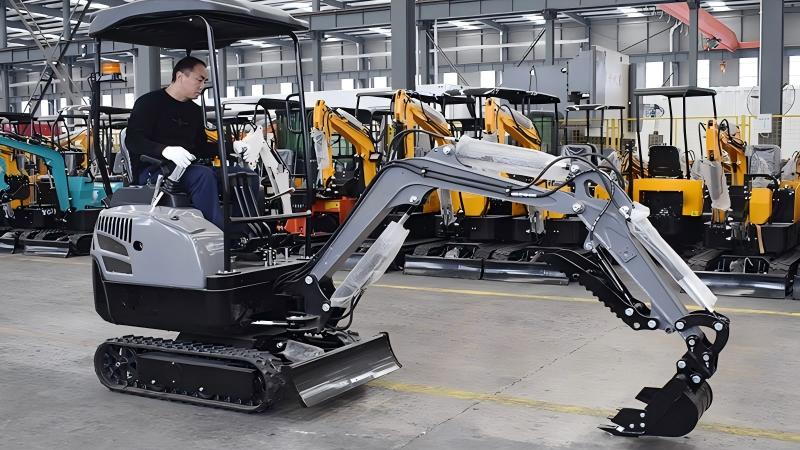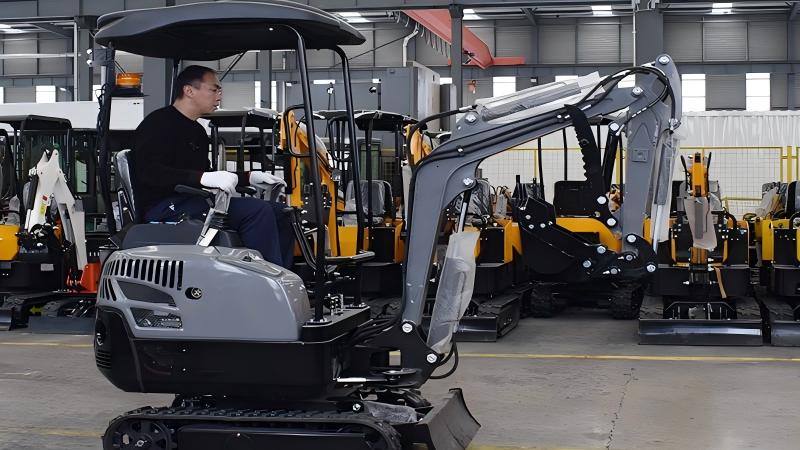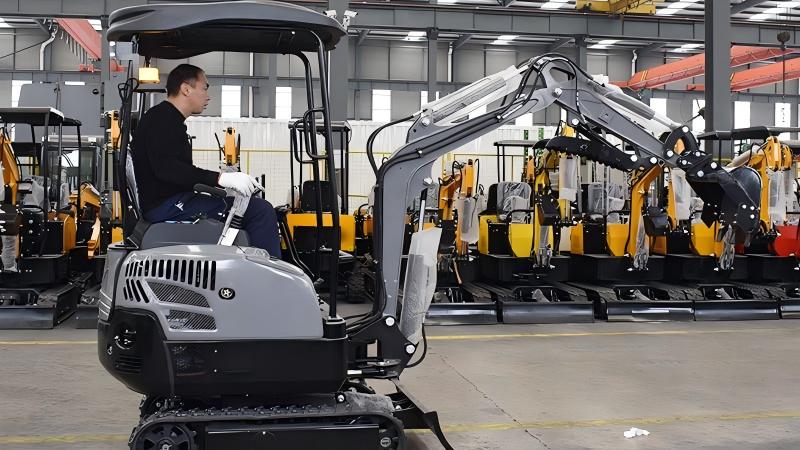Mini Excavator: Precision and Digging Prowess
A mini excavator, also known as a compact excavator, is a tracked or wheeled earthmoving machine characterized by its independent boom swing, compact size, and a house that can rotate 360 degrees. Their operating weights typically range from 0.8 to 8 metric tons.
Key Features and Capabilities:
Digging and Trenching: This is the mini excavator's primary function and where it truly shines. Its articulated boom and arm, coupled with a variety of bucket attachments, allow for precise digging, trenching, and backfilling. The ability to offset the boom independently of the house rotation (boom swing) is crucial for working in confined spaces, alongside walls, or around obstacles.
Precision and Control: Mini excavators offer excellent control for delicate tasks. The independent functions of the boom, arm, bucket, and swing provide a high degree of maneuverability and accuracy, making them ideal for utility work, landscaping, and intricate site preparation.
Versatility with Attachments: Beyond digging, mini excavators can be equipped with a wide range of attachments, including hydraulic hammers (breakers), augers, grapples, thumbs, and compaction wheels. This expands their utility for demolition, post-hole digging, material handling, and compaction.
Operating in Confined Spaces: Their compact size and zero or reduced tail swing designs enable mini excavators to work effectively in tight areas where larger equipment cannot access, such as urban construction sites, residential backyards, and indoor demolition projects.
Minimal Ground Disturbance: The tracks distribute the machine's weight over a larger area, resulting in lower ground pressure. This reduces soil compaction and minimizes damage to existing landscapes, making them suitable for finished sites or sensitive terrains.
Visibility: The elevated operator position generally provides good visibility of the digging area and surroundings.
Advantages of Mini Excavators:
Superior digging depth and reach.
Excellent for trenching, utility installation, and foundation work.
Precise control for intricate tasks.
Ability to work in extremely confined spaces.
Lower ground pressure, ideal for sensitive ground conditions.
360-degree rotation allows for efficient spoil placement without repositioning the entire machine.
Limitations of Mini Excavators:
Slower travel speed compared to skid steers.
Less efficient for pushing or grading large quantities of material over flat surfaces.
Can be less stable on slopes without proper technique and a dozer blade for support.
Higher initial cost for some models compared to similarly sized skid steers.
Can be challenging to transport larger mini excavators without a suitable trailer and tow vehicle.
Skid Steer Loader: Power and Pushing Prowess
A skid steer loader is a rigid-frame, engine-powered machine with lift arms used to attach a wide variety of labor-saving tools or attachments. They are characterized by their "skidding" steering mechanism, where the wheels on one side lock up or slow down, allowing the opposite side to continue turning, thus rotating the machine. They can be wheeled or tracked (compact track loaders - CTLs). While this article generally refers to wheeled skid steers, many of the operational differences also apply when comparing a mini excavator to a CTL.
Key Features and Capabilities:
Loading and Material Handling: Skid steers excel at loading trucks, moving piles of material (dirt, gravel, sand), and backfilling. Their powerful hydraulics and quick-attach systems make them highly efficient for these tasks.
Pushing and Grading: With a bucket or dozer blade attachment, skid steers are excellent for pushing and leveling material over relatively flat terrain. Their robust design allows them to exert significant pushing force.
Versatility with Attachments: Skid steers boast an unparalleled range of attachments, making them incredibly versatile. These include buckets (general purpose, grapple, 4-in-1), forks, trenchers, augers, brooms, snow blowers, mulchers, brush cutters, hydraulic hammers, and cold planers, among many others. This extensive array allows them to perform tasks ranging from landscaping and construction to demolition, agriculture, and snow removal.
Maneuverability (Spin Turns): The skid steer's unique steering system allows it to perform zero-radius turns, making it highly maneuverable in tight spaces, albeit with more ground disturbance than a mini excavator.
Travel Speed: Skid steers generally have a higher travel speed than mini excavators, making them more efficient for moving materials across a job site.
Site Cleanup: Their ability to quickly attach brooms and buckets makes them very efficient for site cleanup at the end of a project.
Advantages of Skid Steer Loaders:
Exceptional versatility due to a vast array of attachments.
Excellent for loading, pushing, and grading.
Faster travel speed for efficient material movement.
Highly maneuverable in tight spaces (spin turns).
Generally lower initial cost than similarly sized mini excavators.
Efficient for site cleanup and debris removal.
Limitations of Skid Steer Loaders:
Limited digging depth and reach compared to a mini excavator.
Less precise for intricate digging tasks, especially in confined areas.
Skid steering causes significant turf damage and ground disturbance, especially on soft or finished surfaces.
Can be less stable on uneven terrain or slopes, particularly with heavy loads.
Reduced visibility of the attachment directly in front of the machine, especially when digging.
Less efficient for trenching unless equipped with a dedicated trencher attachment, which can be slower than a mini excavator.
Mini Excavator vs. Skid Steer: Making the Choice
The "better" machine is entirely project-dependent. Here's a decision-making guide:
Choose a Mini Excavator if your primary tasks involve:
Deep and precise digging: Foundations, utility trenches, irrigation lines.
Working in extremely confined spaces: Residential backyards, urban sites, indoor demolition.
Operating on sensitive ground: Finished lawns, golf courses, areas where minimal ground disturbance is crucial.
Demolition within structures: Breaking up concrete or masonry with a hydraulic hammer in a controlled manner.
Digging around existing obstacles: Pipes, trees, or foundations where boom offset is critical.
Choose a Skid Steer Loader if your primary tasks involve:
Moving large volumes of material: Loading trucks, backfilling, clearing debris.
Grading and leveling: Preparing subgrades, spreading aggregates.
Site cleanup and maintenance: Sweeping, snow removal, general site organization.
Operating a wide variety of attachments for diverse tasks: Brush cutting, stump grinding, post-hole digging (auger), concrete breaking (hammer), trenching (trencher attachment).
Working on relatively flat, open sites where ground disturbance is less of aconcern.
Consider Both if:
For many comprehensive projects, owning or renting both a mini excavator and a skid steer is the most efficient solution. The mini excavator can handle the digging, trenching, and precise earthmoving, while the skid steer can quickly move and grade material, load trucks, and perform general site cleanup. This combination often leads to increased productivity and reduced project timelines.
Cost Considerations:
Generally, a skid steer loader (wheeled) tends to have a lower upfront purchase price than a comparably sized mini excavator. However, attachment costs can vary significantly for both. Operating costs, including fuel and maintenance, are relatively similar, though the type of work performed will influence wear and tear.
Operator Skill:
Both machines require skilled operators for safe and efficient operation. Mini excavators demand finesse and coordination for precise digging, while skid steers require a good understanding of load distribution and stability, especially when working on slopes or with heavy attachments.
Conclusion
Neither the mini excavator nor the skid steer is inherently "better" than the other. They are distinct machines designed for different primary functions. The mini excavator excels at digging, trenching, and precision work in tight spaces with minimal ground disturbance. The skid steer is a master of material handling, loading, grading, and general site utility, boasting unparalleled attachment versatility. By carefully assessing the scope of your projects, the typical tasks you'll perform, and the environmental constraints of your job sites, you can make an informed decision and select the machine – or combination of machines – that will maximize your productivity and profitability.
Post time:Sep-25-2020



